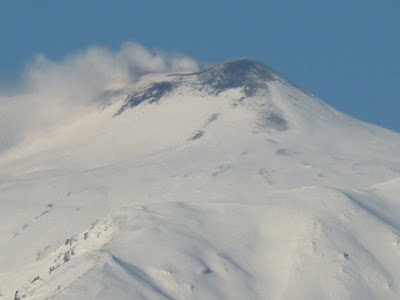Taormina was founded by Greek colonists in 832 BCE. Sicily, as I'll probably have many occasions to observe, is a cross-roads of the Mediterranean, with indigenous paleolithic and neolithic populations, the Greeks, the Carthagenians, the Romans, the Byzantines, the Arabs, the Normans, the Spanish, and more recently, the Italians, the Mafia, and the Japanese tour buses, all putting their stamp on things. The sun never sets on Japanese tour buses. Sicily endures, nonetheless. Taormina is one of the oldest of the Greek colonies, occupying a strategic site, and displaying the traces of all the passing conquerors. These days, it's quite the fashionable resort, even in March.
 |
Photos of Etna in the PM were not so good from Taormina, so here's one from the
road our campground is on; morning; Etna is 11,000 feet, dominates Sicily, is one
of the world's most active volcanoes, summit completely coveredin snow this time of year
|
 |
The road from Giardini Naxos to Taormina absolutely rivals the Amalfi road,
at least for the short stretch; again, we took the bus; this is one of many hair-pins,
so tight there's barely room to walk...
|
 |
Most resorts have tele-cabins heading up to the slopes; Taormina has them
headed down to the beach
|
 |
Anyhow, Taormina is known for many things, chief among which are its 3rd
century Greek theatre, its view of the surrounding mountains and coasts, and,
its long, beautiful Medieval street (next post)
|
 |
Theatre proscenium
|
 |
The views: looking north to the Straits (the Italian mainland on the right)
|
 |
Looking down to the little cove and beach
|
 |
Looking south, across the Bay of Naxos; our campground is on the point
|
 |
Looking west, to the Saracen castle and an even higher hill town
|
 |
It's a big theatre, remodeled by the Romans, now used for summer festival
performances
|
 |
Us
|
 |
Looking up at the still-higher town
|

















































